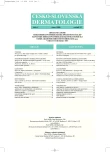Nail Alternariosis – Synergism with Dermatophytes?
Authors:
H. Ryšavá
Authors‘ workplace:
Kožní oddělení, Nemocnice Přerov
primář MUDr. Pavel Zíma
Published in:
Čes-slov Derm, 81, 2006, No. 1, p. 20-25
Category:
Case Reports
Overview
Presented paper informs about clinical course and treatment of bilateral toenail disease of a 57-year-old woman. Results of mycological tests, carried out recently, were not always identical – on the first one Alternaria alternata was proved in the infected tissue, the second examination was negative. During the final one the presence of septate non-pigmentate hyphae in the tissue were detected by direct microscopy and Trichophyton rubrum and Alternaria alternata were growing mixed in the culture. Long duration of the disease (more than 20 years) and its frequent relapses are apparently an expression of well established synergism of the both pathogens. History of the patient indicates that the primary pathogen represented some of dermatophytes, while the non-dermatophyte mould Alternaria alternata invaded the infected tissue secondarily. In the discussion basic literature data concerning the occurrence, clinical course and etiology of an onychomycosis are summarized.
Key words:
onychomycosis – toenails – Alternaria alternata – Trichophyton rubrum – diagnostics – treatment
Labels
Dermatology & STDs Paediatric dermatology & STDsArticle was published in
Czech-Slovak Dermatology

2006 Issue 1
Most read in this issue
- Dermatomycological Diagnostics – What Can Be Read out from a KOH Wet Mount?
- Unusual Case of Microsporum canis Infection
- Nail Alternariosis – Synergism with Dermatophytes?
- Epidermal Stem Cell
